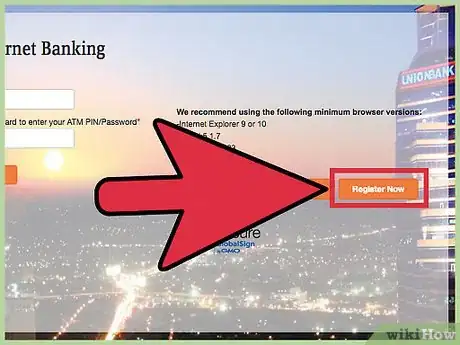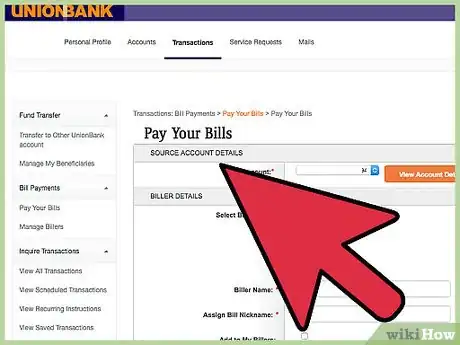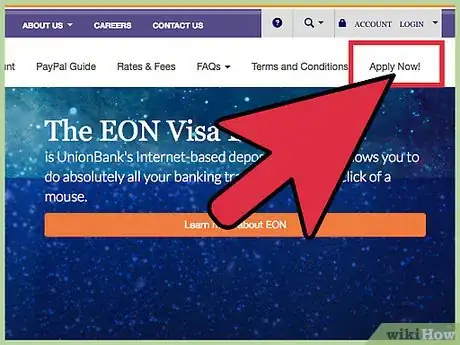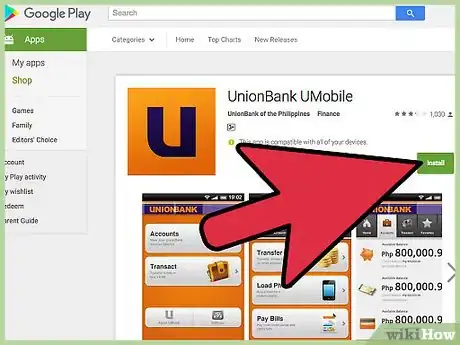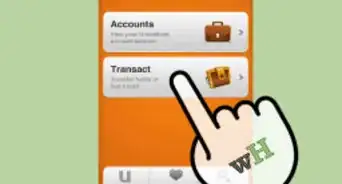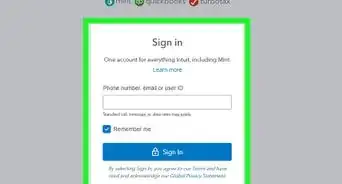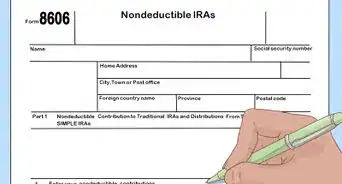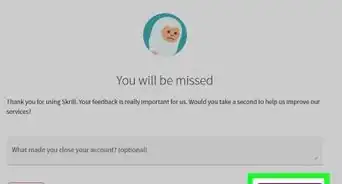This article was co-authored by Samantha Gorelick, CFP®. Samantha Gorelick is a Lead Financial Planner at Brunch & Budget, a financial planning and coaching organization. Samantha has over 6 years of experience in the financial services industry, and has held the Certified Financial Planner™ designation since 2017. Samantha specializes in personal finance, working with clients to understand their money personality while teaching them how to build their credit, manage cash flow, and accomplish their goals.
wikiHow marks an article as reader-approved once it receives enough positive feedback. In this case, several readers have written to tell us that this article was helpful to them, earning it our reader-approved status.
This article has been viewed 247,432 times.
When it comes to monitoring your bank accounts, online banking is a great option. Since many new online-only banks are popping up, understanding how to access your accounts online is an important tool. Setting up your online account, locating and using helpful and important features, and staying secure while banking online are all important parts of using online banking.
Steps
Setting Up Your Account
-
1Open a bank account if you don’t have one already. If you already have a bank account, you can skip this step. In order to use online banking, you’ll need a bank account to access and manage online. Go to a local branch of your preferred bank and open a checking or savings account to get started.
- There are some banks that do not have physical, brick-and-mortar branches. These online-only banks, such as Simple or Ally, rely completely on their web interfaces to service the needs of their customers. To open an account with an online-only bank, simply go to their website and follow the instructions for opening an account.
- When you're choosing a bank, make sure it's FDIC-insured. Also, check current interest rates and compare that to the bank's interest rates to make sure you'll get the best return on any investment accounts.[1]
- Banks like Marcus, Ally, Capital One 360, and Barclays all offer online banking with competitive interest rates.[2]
-
2Set up your online account. Once you have an account with a bank, you will be able to go onto their website and enable online access to your accounts. You will need some kind of identification that is associated with your account, such as a Social Security number, Federal ID number, driver’s license number, birth date, and/or account number. Follow the online instructions for opening an account and gather the information you will need to proceed.
- You will likely need your account number in order to set up an online account, so have that handy. A banker or teller at your bank should be able to provide you with this number if you don’t have it, so call your bank or visit a branch to get it.
- On the homepage of your bank’s website, look for an option to “Enroll,” “sign up,” or “open an online account.”
- Call or visit the bank and ask a banker for help if you have trouble setting up your online account. Most banks will have a toll-free 800-number available for customer service that you can call if you need help.
Advertisement -
3Choose a secure username and password. Follow the online portal’s requirements for the username and password. For extra safety, include special characters, numbers, and upper and lowercase letters in your password. If you fear you’ll have trouble remembering it, write it down and keep it in a secure place. Select a username you don’t already use for another account. If you’re using your name, consider adding numbers to make it more unique.
- Avoid using the same password for multiple accounts. Also, avoid using birthdates, social security numbers, and other identifiable information in your passwords or usernames.
-
4Set up your contact information. As part of the sign-up process, you will likely be asked for your contact information. Match this to the information your bank already has on file. You will be able to use this online portal to change your contact and billing information in the future, and it’s important you always know what address the bank has on file for you, as certain transactions with your bank card might require a billing zip code for verification.
- When inputting your contact email address, make sure to use an email account that you check daily or frequently in case the bank needs to send you any important information via email, or in case you lose or forget your password and need to be emailed a new one.
Finding and Using Important Features and Pages
-
1Learn your way around the portal. Once you’ve setup your account, take some time to click around the banking portal and learn where things are. If you have multiple accounts, click on each one and see how each account looks when opened and broken down into more detail. Find the “logout” button so you can securely log out of your banking sessions each time you finish.
- It’s important to understand the way your specific banking system is set up and where important pages can be located. Simply taking some time to explore the interface is the key to learning the ins and outs of your online banking portal.
- A banker or customer service agent from your bank would likely be available to help show you around the website. Give your bank a call or visit a branch for help if you feel you need it.
-
2Opt out of paper statements. One great feature of online banking is the option for getting digital or electronic bank statements rather than the traditional paper statements. Not only is this better for the environment as it saves paper, it can help you stay more organized and on top of your accounts. Most online banking portals will have a tab where you can view your statements in electronic form, sometimes as a .PDF that you can also save to your own harddrive.[3]
- Usually, there will be an option in your online banking portal to stop all paper statements from being mailed to your home and switch entirely to digital statements. Choose this option if you’re interested.
- Some banks offer incentives to customers who want to switch to electronic statements, like a small percentage docked from the interest rates on credit lines. Check with your bank to see if there are any perks for switching to digital statements.
-
3Use online bill pay. Many banks offer a free bill pay service through your online banking portal where you can pay utilities, rent, and other monthly charges. You might also have the option to schedule these payments ahead of time and not even have to worry about them each month. Many services now have the option to link your bank account for automatic payments, which you can then monitor through your online banking portal.[4]
- Remember: only set up automatic or scheduled payments if you are sure the funds will be in your account on the day those bills will process. You won’t want to get hit with any overdraft fees.
- To keep track of your bills, try writing them all down in a notebook, or enter them all into a spreadsheet. You can also use a budgeting software to give you more tools to track your bills and spending.[5] in
-
4Apply for lines of credit or loans through the online portal. Once you are a customer of a bank and have an account with them, you can often use the online banking portal to sign up for new accounts as well. Once you’re logged in, all the information the bank has on file for you can be accessed, so applying for new lines of credit, opening new accounts, or even applying for loans or mortgages can sometimes be done right from the comfort of your home.[6]
-
5Check for special offers or messages in the portal. Online banking portals often have message inboxes where you will be securely notified of new account statements, and changes to your account information. Make sure you locate this inbox and check it regularly. Not only will you find these important account alerts, you might also find customer-only offers for new banking products. Credit lines with low introductory interest rates, high-yield savings accounts, and other services might be offered to you specifically through that message inbox.
- These alerts may or may not also forward to the personal email account you have tied to the banking account. Some online portals might require you to specifically select this option in the settings of your online banking inbox.
-
6Transfer money between accounts. If you have multiple accounts with one bank, you can use your online banking portal to transfer money between those accounts. You can also send money to other people who have accounts at the same bank, and even to people with accounts at partner banks. For example, Wells Fargo and Bank of America allow their customers to transfer money between accounts at the two banks.
- Make sure you know what fees may apply to this service. For the most part, transfers between your own accounts will come as a free service, but federal law prohibits more than 6 transfers from a savings account to a checking account in one month. When using the transfer tool on your banking portal, any fees will be listed prior to you confirming the transfer.
-
7Use a mobile banking application. Many banks have smartphone apps you can download and access on the go. Simply search for your bank in the app store on your smartphone and download the application. Make sure the app is created, owned, and operated by your bank. You will likely see offers or advertisements for this app on the bank’s website or in the branches. Some banks even offer the option to deposit checks with the camera on your smartphone. You can also use these apps to transfer money, monitor account balances, and locate nearby ATMs and branches.
Staying Secure
-
1Avoid using online banking on public WiFi. When you are connected to a public WiFi connection, avoid inputting any personal information, including passwords and banking information. There are ways for hackers and thieves to steal your information when it is transmitted over unencrypted signals, which is often the case with public or free WiFi connections.[7]
- If you rely on this kind of connection, consider downloading an encryption software onto your browser to keep your information safe.
-
2Stay aware of your surroundings when banking on your smartphone in public. Just like when you type in your PIN at the ATM, you will want to make sure no one can see your screen if you are banking online in a public place. If you’re using your smartphone to check your balance, for example, make sure no one is looking over your shoulder or standing very close by. Keep passwords and balance information private from onlookers.
- Cover the screen of your phone or laptop with your hand if you’re worried about prying eyes, or simply wait until you are at home or in a private place to access your online banking information.
-
3Monitor your accounts for any signs of fraud or theft. One of the best ways to make sure your accounts are secure is to monitor them for signs of any unauthorized charges. Online banking offers 24/7 access to your accounts, which makes it easier to monitor the activity in them. If you see any charges you don’t remember making yourself, contact the bank immediately. Have the charges open in front of you for easy reference and access.[8]
Expert Q&A
Did you know you can get expert answers for this article?
Unlock expert answers by supporting wikiHow
-
QuestionWhat are a few good online banks?
 Samantha Gorelick, CFP®Samantha Gorelick is a Lead Financial Planner at Brunch & Budget, a financial planning and coaching organization. Samantha has over 6 years of experience in the financial services industry, and has held the Certified Financial Planner™ designation since 2017. Samantha specializes in personal finance, working with clients to understand their money personality while teaching them how to build their credit, manage cash flow, and accomplish their goals.
Samantha Gorelick, CFP®Samantha Gorelick is a Lead Financial Planner at Brunch & Budget, a financial planning and coaching organization. Samantha has over 6 years of experience in the financial services industry, and has held the Certified Financial Planner™ designation since 2017. Samantha specializes in personal finance, working with clients to understand their money personality while teaching them how to build their credit, manage cash flow, and accomplish their goals.
Financial Planner
Warnings
- Never store passwords when using a public computer.⧼thumbs_response⧽
- Alert your bank to any suspicious activity on your accounts.⧼thumbs_response⧽
References
- ↑ Samantha Gorelick, CFP®. Financial Planner. Expert Interview. 6 May 2020.
- ↑ Samantha Gorelick, CFP®. Financial Planner. Expert Interview. 6 May 2020.
- ↑ http://www.makeuseof.com/tag/7-best-online-banking-features-simplifying-life/
- ↑ http://www.makeuseof.com/tag/7-best-online-banking-features-simplifying-life/
- ↑ Samantha Gorelick, CFP®. Financial Planner. Expert Interview. 6 May 2020.
- ↑ http://www.finweb.com/banking-credit/online-banking-advantages-and-disadvantages.html#axzz4DlTyUUrA
- ↑ http://en.community.dell.com/dell-blogs/direct2dell/b/direct2dell/archive/2014/07/23/how-hackers-use-wi-fi-to-steal-your-passwords
- ↑ http://files.consumerfinance.gov/f/201401_cfpb_consumer-advisory_card-security.pdf
About This Article
Once you have an online banking account, you can use it to perform some transactions like paying bills. Typically, you can do so by clicking a tab titled “Transactions” or something similar, and then filling out the form for paying bills. You should also be able to transfer money between your accounts with that bank by clicking the same tab. In addition, some banks have downloadable apps that let you deposit checks by taking a picture with your smartphone. To learn how to set up an online bank account and use it securely, scroll down!


